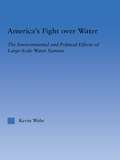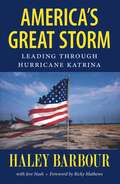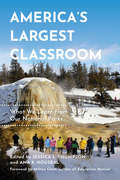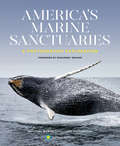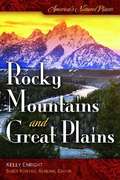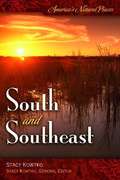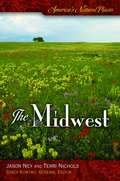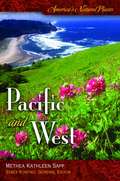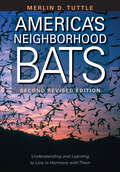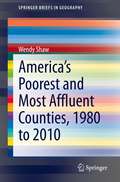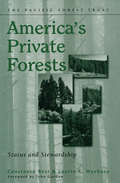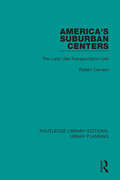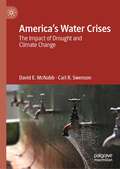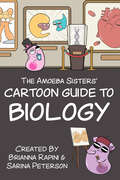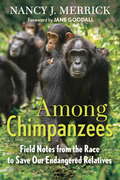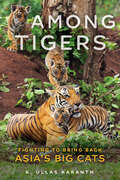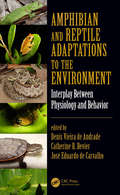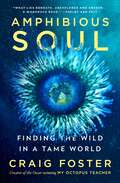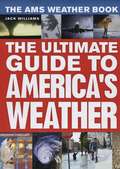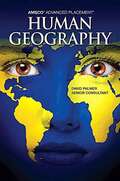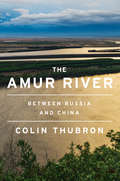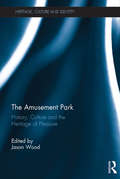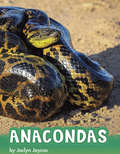- Table View
- List View
America's Fight Over Water: The Environmental and Political Effects of Large-Scale Water Systems (Studies in American Popular History and Culture)
by Kevin WehrThis book inquires into the relations between society and its natural environment by examining the historical discourse around several cases of state building in the American West: the construction of three high dams from 1928 to 1963.
America's Great Storm: Leading through Hurricane Katrina
by Haley BarbourWhen Hurricane Katrina hit Mississippi on August 29, 2005, it unleashed the costliest natural disaster in American history, and the third deadliest. Haley Barbour had been Mississippi's governor for only twenty months when he assumed responsibility for guiding his pummeled, stricken state's recovery and rebuilding efforts. America's Great Storm is not only a personal memoir of his role in that recovery, but also a sifting of the many lessons he learned about leadership in a time of massive crisis. For the book, the authors interviewed more than forty-five key people involved in helping Mississippi recover, including local, state, and federal officials as well as private citizens who played pivotal roles in the weeks and months following Katrina's landfall. In addition to covering in detail the events of September and October 2005, chapters focus on the special legislative session that allowed casinos to build on shore; the role of the recovery commission chaired by Jim Barksdale; a behind-the-scenes description of working with Congress to pass an unprecedented, multi-billion-dollar emergency disaster assistance appropriation; and the enormous roles played by volunteers in rebuilding the entire housing, transportation, and education infrastructure of South Mississippi and the Gulf Coast. A final chapter analyzes the leadership skills and strategies Barbour employed on behalf of the people of his state, observations that will be valuable to anyone tasked with managing in a crisis.
America's Largest Classroom: What We Learn from Our National Parks
by Jessica L. ThompsonOver the past 100 years, visitor learning at America’s national parks has grown and evolved. Today, there are over 400 National Park Service (NPS) sites, representing over eighty million acres. Sites exist in every US state and territory and are located on land, at sea, in remote areas, and in major urban centers. Every year, more than 300 million people visit national parks, and several million of them are children engaged in one of many educational programs hosted by the NPS.America’s Largest Classrooms offers insight and practical advice for improving educational outreach at national parks as well as suggestions for classroom educators on how to meaningfully incorporate parks into their curricula. Via a wide collection of case studies—ranging from addressing inclusivity at parks and public lands to teaching about science and social issues—this book illustrates innovations and solutions that will be of interest to nature interpreters, outdoor educators, and policy makers, as well as professors in the sciences writ large.
America's Marine Sanctuaries: A Photographic Exploration
by NAT'L MARINE SANCTUARY FDNAn extraordinary illustrated overview of the National Marine Sanctuary System and a guide to its fourteen protected underwater locationsAmerica's Marine Sanctuaries tells the story of fourteen underwater places so important they are under special protection, together forming the US National Marine Sanctuary System. These sanctuaries, spanning more than 620,000 square miles and ranging from the Florida Keys to the Great Lakes and to the Hawaiian Islands, are critical and breathtaking marine habitats that provide homes to endangered and threatened species. They also preserve America's rich maritime heritage and act as living laboratories for science, research, education, and conservation, offering outdoor recreation experiences for all ages. Through 175 full-color photographs and lively narrative, America's Marine Sanctuaries showcases each of the marine sanctuaries and the creatures that live there, from whales and manatees to Hawaiian monk seals and Laysan ducks, as well as sunken ships from the Ghost Fleet and USS Monitor to Shipwreck Alley. The book underscores how marine sanctuaries have shaped the nation's development, survival, and identity, and celebrates these protected underwater treasures for all they can tell us about our communities, our country, and our world.
America's Natural Places: Rocky Mountains And Great Plains
by Kelly EnrightFrom Rocky Mountain National Park in Colorado to the Tallgrass Prairie National Preserve in Kansas, this volume provides a snapshot of the most spectacular and important natural places in the Great Plains and Rocky Mountains.
America's Natural Places: South And Southeast
by Stacy S. KowtkoFrom the Texas Blackland Prairies to the Middle Atlantic Coastal Plain of the Carolinas, this volume provides a snapshot of the most spectacular and important natural places in the southern United States.
America's Natural Places: The Midwest
by Jason Ney Terri NicholsFrom Iowa's Decorah Ice Cave to the Kitty Todd Nature Preserve in Ohio, this volume provides a snapshot of the most spectacular and important natural places in the Midwestern United States.
America's Natural Places: Pacific And West
by Methea K. SappFrom Alaska As Arctic National Wildlife Refuge to the Milnes and Prairie Preserve of New Mexico, this volume provides a snapshot of the most spectacular and important natural places in the western United States.
America's Neighborhood Bats: Understanding and Learning to Live in Harmony with Them (Revised Edition)
by Merlin D. TuttleA guide to these frequently misunderstood animals that dispels unnecessary fears and encourages an appreciation of bats and their conservation needs. Since its publication in 1988, America&’s Neighborhood Bats has changed the way we look at bats by underscoring their harmless and beneficial nature. In this revised edition, Merlin Tuttle offers bat aficionados the most up-to-date bat facts, including a wealth of new information on attracting bats and building bat houses and a revamped key to the identification of common North American species. The easy-to-understand text, clear illustrations, and spectacular color photographs make this the perfect bat book for the general reader, as well as an invaluable resource for professionals who field questions from the public. Those who provide advice at health and animal control departments, museums, zoos, and nature centers will find it especially useful.
America’s Poorest and Most Affluent Counties, 1980 to 2010 (SpringerBriefs in Geography)
by Wendy ShawThis book explores the changing spatial distribution of the United States of America's poorest and most affluent counties over the 30 years from 1980 to 2010. While overall rates of poverty have changed somewhat during this period, the geography of counties where affluence and poverty rates are the highest have also shifted as economic fortunes wax and wane. The spatial understanding of poverty and affluence is an important dimension of addressing the complex economic and social contexts within which poverty occurs, and which vary substantially depending on several factors. While there has been significant focus on poverty in the United States, including some analysis of its spatial characteristics, since the 1960s there has been relatively little research on the concomitant geography of affluence. The geographies of poverty and affluence analyzed in this book give a view of spatial economic segregation. Spatial aspects of both the poorest and most affluent counties are focused on, as well as the changing gap and relative geographies between rich and poor over three decades.
America's Private Forests: Status And Stewardship
by John Gordon Laurie A. Wayburn Constance Best Pacific Forest TrustNearly 430 million acres of forests in the United States are privately owned, but the viability, and indeed the very existence, of these forests is increasingly threatened by population growth, sprawling urbanization, and patchwork development. Scientists, policymakers, and community leaders have begun to recognize the vital role of private forests in providing society with essential goods and services, from sustainable timber supplies to clean water. Yet despite the tremendous economic and ecological importance of private forests, information about their status and strategies for their protection have been in short supply.America's Private Forests addresses that shortcoming, presenting extensive data gathered from diverse sources and offering a concise overview of the current status of privately owned forests in the United States. As well as describing the state of private forests, the book sets forth detailed information on a wide range of approaches to conservation along with an action agenda for implementing those strategies likely to be most effective.Based on extensive research of existing literature as well as interviews and consultation with leading forestry and conservation experts, America's Private Forests is a unique sourcebook that offers a solid basis for discussion of threats to private forests along with an invaluable compendium of potential solutions. It will serve as an invaluable reference for those working to conserve and steward forest resources, including forest owners and their consultants, conservation organizations, and agency personnel, as well as researchers and students involved with issues of forestry, biodiversity, land use, and conservation.
America's Suburban Centers: The Land Use-Transportation Link (Routledge Library Editions: Urban Planning #6)
by Robert CerveroOriginally published in 1989, America’s Suburban Centers looks at how America’s suburban workplaces are being increasingly designed for automobiles rather than people. The emergence of sprawling office complexes devoid of housing, shops and other facilities is giving rise to regional congestion problems because of the ever-greater dependence on automobiles. This book argues that the low-density, single-use, and non-integrated character of America’s suburban centers is a root cause of declining levels of mobility and worsening traffic congestion.
America’s Water Crises: The Impact of Drought and Climate Change
by David E. McNabb Carl R. SwensonThis book is focused exclusively on water problems in the 48 U.S. states. The authors provide an accessible overview of the work of many federal, state and academic researchers and water system administrators whose investigations have focused on the state of water and the water crisis now accelerating in the United States. David McNabb and Carl Swenson seek to bring to a wider audience some of the current research findings and data on the perilous state of the United States’ surface and groundwater resources during this time of climate change and the extreme drought taking place in many sections of the nation. Descriptions of the water resource systems are based on research and the subsequent findings published by water scientists in the United States Geological Survey, the Environmental Protection Agency, the U.S. Corps of Engineers and water related agencies of the Departments of Agriculture and of the Interior and state and local water management agencies.
Amity and Prosperity: One Family and the Fracturing of America
by Eliza Griswold<p>In Amity and Prosperity, the prizewinning poet and journalist Eliza Griswold tells the story of the energy boom’s impact on a small town at the edge of Appalachia and one woman’s transformation from a struggling single parent to an unlikely activist. <p>Stacey Haney is a local nurse working hard to raise two kids and keep up her small farm when the fracking boom comes to her hometown of Amity, Pennsylvania. Intrigued by reports of lucrative natural gas leases in her neighbors’ mailboxes, she strikes a deal with a Texas-based energy company. Soon trucks begin rumbling past her small farm, a fenced-off drill site rises on an adjacent hilltop, and domestic animals and pets start to die. When mysterious sicknesses begin to afflict her children, she appeals to the company for help. Its representatives insist that nothing is wrong. <p>Alarmed by her children’s illnesses, Haney joins with neighbors and a committed husband-and-wife legal team to investigate what’s really in the water and air. Against local opposition, Haney and her allies doggedly pursue their case in court and begin to expose the damage that’s being done to the land her family has lived on for centuries. Soon a community that has long been suspicious of outsiders faces wrenching new questions about who is responsible for their fate, and for redressing it: The faceless corporations that are poisoning the land? The environmentalists who fail to see their economic distress? A federal government that is mandated to protect but fails on the job? Drawing on seven years of immersive reporting, Griswold reveals what happens when an imperiled town faces a crisis of values, and a family wagers everything on an improbable quest for justice.</p>
The Amoeba Sisters' Cartoon Guide to Biology
by Brianna Rapini Sarina Peterson24 Major Biology Topics You Should KnowExplore the wonders of biology inside and outside of the classroom with The Amoeba Sisters’ Cartoon Guide to Biology. Science facts made easy. From the dynamic sister duo behind the beloved Amoeba Sisters YouTube channel, this visual learning book features 24 major educational concepts commonly taught in life sciences courses. Designed to alleviate the intimidation often associated with complex science concepts, this guide employs amusing mnemonics, real-world examples, and light-hearted humorous anecdotes to make biology topics more approachable and relatable.Designed for anyone studying biology. Whether you’re a high school student, a college scholar, or a curious biology enthusiast, this book ensures that learning biology remains engaging and accessible for all ages to enjoy. This book tackles topics students often find difficult, such as cell transport, cellular respiration, protein synthesis, DNA replication, mitosis, and meiosis, with each chapter addressing stumbling blocks they may encounter in the classroom or during study prep. Whether used as an introduction to a concept or to recap a lesson, this book also makes a great supplement to your biology textbook as a classroom set.Pairs well with any biology course.Illustrations, diagrams, and cartoons break down complex biology conceptsShort chapters provide a biology foundation in the style of Amoeba Sisters videosUseful for teachers and students, includes objectives at end of each chapter to help with test preparationGlossary of over 250 biology vocabulary words with easy-to-understand, brief definitionsSo if you enjoy teen and kid science books such as Physics for Curious Kids, Awesome Facts That Will Make You Look Super Smart, or Noah’s Fascinating World of STEAM Experiments, then you’ll love The Amoeba Sisters’ Cartoon Guide to Biology.
Among Chimpanzees
by Nancy J. Merrick Jane GoodallA former student and colleague of Jane Goodall shares stories of chimps and their heroes, and takes readers on a journey to save man's closest relative. Unbeknownst to much of the public, chimps are in trouble: censuses show them to be extinct in four African countries and nearly so in ten others. A large percentage of the remaining populations live in unprotected, increasingly fragmented forests. When Nancy Merrick learned these startling facts in 2009, she decided it was past time to discover the extent to which chimpanzees are at risk across Africa and what can be done. Merrick had begun working with primates in 1972 as a young field assistant in Jane Goodall's famous Gombe camp. Like the rest of the world at the time, she was swept up in the excitement of discovering the remarkable world of chimpanzees--their ability to fashion tools, their dazzling intelligence, and their complex relationships and societies. From that moment on, her human-centered worldview shifted, and she became a devoted advocate for our closest genetic relatives. When Merrick returns to Africa decades later, she's alarmed by how much has changed. Human activity, such as agriculture and logging, has encroached on natural habitats throughout equatorial Africa, endangering chimpanzees, gorillas, and bonobos. In an effort to understand what we can do to save great apes, Merrick connects with primatologists and conservationists who are trying to protect the last great forests. Visits to some of Africa's parks, sanctuaries, and expanding agricultural areas reveal the urgency of the problems and the inspiration of the people leading the search for solutions. Along the way, Merrick demonstrates that the best hope for chimps and other great apes lies in connecting conservation to humanitarian efforts, ensuring a healthy future for animals and humans alike. Among Chimpanzees is at once an inspiring chronicle of Merrick's personal search to learn how chimps are faring across Africa and in captivity, a crucial eyewitness account of a very critical period in their existence, and a rousing call for us to join the efforts to be a voice for the chimpanzees, before it's too late.From the Hardcover edition.
Among Tigers: Fighting to Bring Back Asia's Big Cats
by K. Ullas KaranthToday ten times more tigers live in captivity than survive in the wild. For over five decades, K. Ullas Karanth has been engaged in the struggle to bring wild tigers back from the brink in India, their last remaining wild stronghold. He tells the story of the tiger itself—its incredible biology, its critical role in shaping natural ecosystems of Asia, and the unique place it holds in our collective imagination.Among Tigers is the story of how we wound up with fewer than 5,000 wild tigers, and how, with focused efforts we can grow that population ten times or more in a few decades. In doing so, we would bring not only the world's largest and most beloved feline back from the brink, but also save countless other species that share the tigers habitats from the freezing forests of Siberia to the tropics of India. Karanth shares the adventurous real-life story of his quest to save a species and, along the way, the hopeful realization that tiger conservation is a battle that can be won.Ultimately, the book is a roadmap showing us how to not only to save the greatest of great cats, but to bring it roaring back at numbers never before seen in our lifetimes.
Amphibian and Reptile Adaptations to the Environment: Interplay Between Physiology and Behavior
by Denis Vieira de Andrade Catherine R. Bevier José Eduardo de CarvalhoDespite their diversity, amphibians and reptiles share many physiological traits, such as their dependence on external heat sources for body temperature regulation, that are of pivotal importance to their ability to cope with the environment. Considerable variation in physiological capabilities exists in these groups and often can be related to seasonal and geographic differences in environmental parameters. This book provides a comprehensive and integrative view of the interplay between physiology and behavior in amphibians and reptiles, leading to a better understanding of the subject. The book covers topics that have recently been in the spotlight for scientific research on the physiology, behavior, and conservation of amphibians and reptiles. It brings together recent information from a range of disciplines that address critical topics for understanding their biology. As these studies are scattered across articles in specialized journals, this book provides a single and expanded source summarizing such advancements. Amphibian and Reptile Adaptations to the Environment: Interplay Between Physiology and Behavior maintains a solid scientific basis for the biological topics covered. However, it presents the material in a clear and direct manner so that it is accessible even to non-biologists interested in the basic biology, behavior, and ecology of these animals as well as how these elements are connected to their conservation.
Amphibious Concepts at the Edge of the Sea (Cities Research Series)
by Joerg Baumeister Ioana C. Giurgiu Daniela A. OttmannThis book explores interfaces between land and sea and their geostrategic, ecological, urban, productive, indigenous, legal, historical, and artistic dimensions. The oceans, comprising two-thirds of the earth's surface, were initially utilised mainly for transportation and fishing. Today they serve diverse purposes such as supplying energy, freshwater, mineral resources, supporting leisure activities, and providing habitat. Additionally, the UN set up the first international agreement establishing Marine Protection Areas for a third of the sea to mitigate the growing use and exploitation. The more interest in oceans' territories increases, the more the question arises about the beneficial evolution of their physical and legal boundaries. What innovative amphibious concepts can be developed for the edge of the sea? The book pushes the boundaries of current knowledge to provide a deeper insight into the upcoming challenges and opportunities, makingit easier to apply the best strategies for a healthy future for both the ocean and humanity.
Amphibious Soul: Finding the Wild in a Tame World
by Craig Foster“An important book that will transform how we think about being human. … that will inspire hope.”—Jane GoodallHow can we reclaim the soul-deepening wildness that grounds us and energizes us when so much of the modern world seems designed to tame us?In this thrilling memoir of a life spent exploring the most incredible places on Earth—from the Great African Seaforest to the crocodile lairs of the Okavango Delta—Craig Foster reveals how we can attend to the earthly beauty around us and deepen our love for all living things, whether we make our homes in the country, the city, or anywhere in between.Foster explores his struggles to remain present to life when a disconnection from nature and the demands of his professional life begin to deaden his senses. And his own reliance on nature’s rejuvenating spiritual power is put to the test when catastrophe strikes close to home.Foster’s lyrical, riveting Amphibious Soul draws on his decades of daily ocean dives, wisdom from Indigenous teachers, and leading-edge science.
The AMS Weather Book: The Ultimate Guide to America's Weather
by Jack Williams Stephanie Abrams Rick Anthes Jim CantoreAmerica has some of the most varied and dynamic weather in the world. Every year, the Gulf Coast is battered by hurricanes, the Great Plains are ravaged by tornados, the Midwest is pummeled by blizzards, and the temperature in the Southwest reaches a sweltering 120 degrees. Extreme weather can be a matter of life and death, but even when it is pleasant--72 degrees and sunny--weather is still central to the lives of all Americans. Indeed, it's hard to imagine a topic of greater collective interest. Whether we want to know if we should close the storm shutters or just carry an umbrella to work, we turn to forecasts. But few of us really understand the science behind them. All that changes with The AMS Weather Book. The most comprehensive and up-to-date guide to our weather and our atmosphere, it is the ultimate resource for anyone who wants to understand how hurricanes form, why tornados twirl, or even why the sky is cerulean blue. Written by esteemed science journalist and former USA Today weather editor Jack Williams, The AMS Weather Book, copublished with the American Meteorological Society, covers everything from daily weather patterns, air pollution, and global warming to the stories of people coping with severe weather and those who devote their lives to understanding the atmosphere, oceans, and climate. Words alone, of course, are not adequate to explain many meteorological concepts, so The AMS Weather Book is filled with engaging full-color graphics that explain such concepts as why winds blow in a particular direction, how Doppler weather radar works, what happens inside hurricanes, how clouds create wind and snow, and what's really affecting the earth's climate. For Weather Channel junkies, amateur meteorologists, and storm chasers alike, The AMS Weather Book is an invaluable tool for anyone who wants to better understand how weather works and how it affects our lives.
AMSCO Advanced Placement Human Geography
by David PalmerEquip your students to excel in the current AP Human Geography course and on the exam.
The Amur River: Between Russia and China
by Colin ThubronThe most admired travel writer of our time—author of Shadow of the Silk Road and To a Mountain in Tibet—recounts an eye-opening, often perilous journey along a little known Far East Asian river that for over a thousand miles forms the highly contested border between Russia and China.The Amur River is almost unknown. Yet it is the tenth longest river in the world, rising in the Mongolian mountains and flowing through Siberia to the Pacific. For 1,100 miles it forms the tense border between Russia and China. Simmering with the memory of land-grabs and unequal treaties, this is the most densely fortified frontier on earth. In his eightieth year, Colin Thubron takes a dramatic journey from the Amur’s secret source to its giant mouth, covering almost 3,000 miles. Harassed by injury and by arrest from the local police, he makes his way along both the Russian and Chinese shores, starting out by Mongolian horse, then hitchhiking, sailing on poacher’s sloops or travelling the Trans-Siberian Express. Having revived his Russian and Mandarin, he talks to everyone he meets, from Chinese traders to Russian fishermen, from monks to indigenous peoples. By the time he reaches the river’s desolate end, where Russia’s nineteenth-century imperial dream petered out, a whole, pivotal world has come alive. The Amur River is a shining masterpiece by the acknowledged laureate of travel writing, an urgent lesson in history and the culmination of an astonishing career.
The Amusement Park: History, Culture and the Heritage of Pleasure (Heritage, Culture and Identity)
by Jason WoodJason Wood is Director of Heritage Consultancy Services, Lancaster, UK, and former Professor of Cultural Heritage at Leeds Metropolitan University, UK.
Anacondas (Animals)
by Jaclyn JaycoxAnacondas are the heaviest snakes in the world! These big snakes use their bodies to squeeze their prey. Anacondas can be as long as a bus and can stay underwater for a long time while hunting. Slither towards the facts on these powerful snakes. <P><P><i>Advisory: Bookshare has learned that this book offers only partial accessibility. We have kept it in the collection because it is useful for some of our members. Benetech is actively working on projects to improve accessibility issues such as these.</i>
